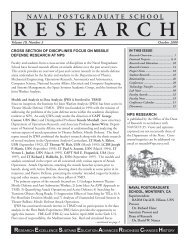Spectral Unmixing Applied to Desert Soils for the - Naval ...
Spectral Unmixing Applied to Desert Soils for the - Naval ...
Spectral Unmixing Applied to Desert Soils for the - Naval ...
Create successful ePaper yourself
Turn your PDF publications into a flip-book with our unique Google optimized e-Paper software.
spectrometer, reflectance values were used <strong>to</strong> identify regions of change in absorption<br />
feature overall spectral reflectance <strong>for</strong> <strong>the</strong> zunyite mixtures. These endmembers were<br />
also analyzed using <strong>the</strong> continuum removed method <strong>to</strong> calculate <strong>the</strong> absorption depths at<br />
500 nm, 1125 nm, and 2200 nm <strong>for</strong> endmembers. Absorption feature depths <strong>for</strong><br />
endmembers 6, 9, 14, 28, 34, 43, and 42 are 0.056, 0.133, 0.0340; 0.225, 0.1281, 0.0350;<br />
0.034, 0.0693, 0.0376; 0.028, 0.0688, 0.0535; 0.047, 0.076, 0.0293; 0.026, 0.128, 0.050,<br />
and 0.109, 0.301, 0.117, respectively (Table 3). The similarity between <strong>the</strong> band depth<br />
calculation results of both <strong>the</strong> user-supplied endmembers and <strong>the</strong> imagery-derived<br />
endmembers suggest that differences in <strong>the</strong> features can potentially be related <strong>to</strong> different<br />
levels of disturbance affecting <strong>the</strong> surface material (Table 3). The spectra in Figure 28<br />
also show slight shifts in location and prominence of <strong>the</strong> features. Widths of features in<br />
this case varied as well.<br />
For <strong>the</strong> clay collect, <strong>the</strong> hill clay sample appeared <strong>to</strong> be <strong>the</strong> least impacted by<br />
disturbance and was <strong>the</strong>re<strong>for</strong>e used as a control <strong>to</strong> determine <strong>the</strong> disturbance-related<br />
differences. Since <strong>the</strong> least impacted clay sample had similar reflectance characteristics<br />
<strong>to</strong> <strong>the</strong> imagery derived zunyite endmember 28, that endmember was used <strong>for</strong> <strong>the</strong> zunyite<br />
control. The average differences in absorption depth at 500 nm, 1125 nm, and 2200 nm<br />
<strong>for</strong> <strong>the</strong> ASD collected clay spectra and imagery derived zunyite endmembers are 0.0342,<br />
0.0190, .0738; 0.0476, 0.0553, and 0.0207, respectively (Table 2). These values shown<br />
represent <strong>the</strong> difference in depth of absorption features (including <strong>the</strong> averages) at each<br />
respective wavelength <strong>for</strong> two different materials with similar, not identical properties.<br />
Since <strong>the</strong>se materials are similar, not identical, some minor differences are expected.<br />
For example, impact-related disturbances in <strong>the</strong> clay showed a decrease in <strong>the</strong><br />
feature at 2200 nm; endmembers derived from <strong>the</strong> imagery also showed patterns of<br />
absorption features decreasing in <strong>the</strong> SWIR region of <strong>the</strong> electromagnetic spectrum with<br />
respect <strong>to</strong> what is thought <strong>to</strong> be an undisturbed zunyite spectrum; but unlike <strong>the</strong> clay, <strong>the</strong>y<br />
show an increase at 1125 nm. While <strong>the</strong> patterns of feature depth do not match those of<br />
<strong>the</strong> clay at 1125 nm, <strong>the</strong> correlation is still possible because <strong>the</strong> clay and zunyite materials<br />
are not an exact match. Certain features may express <strong>the</strong>mselves differently at 1125 nm<br />
because those features are related <strong>to</strong> vibrational processes while wavelengths less than<br />
58
















